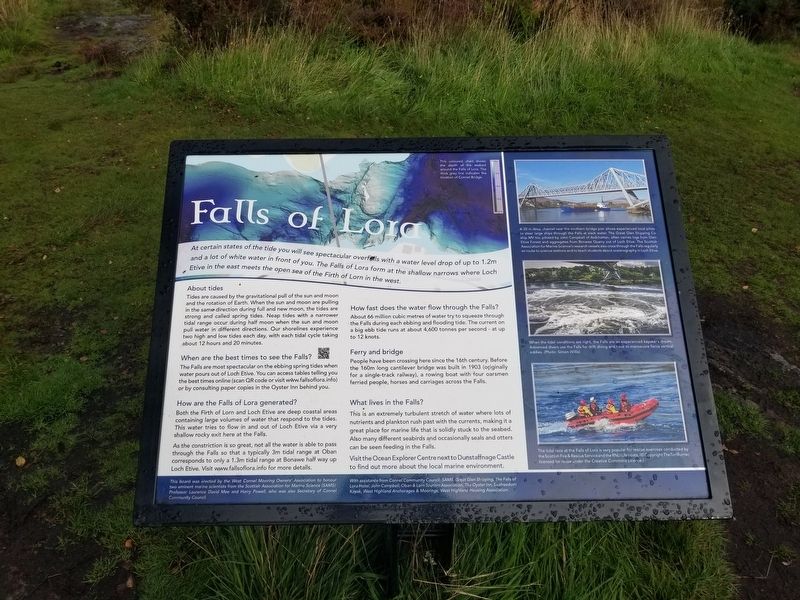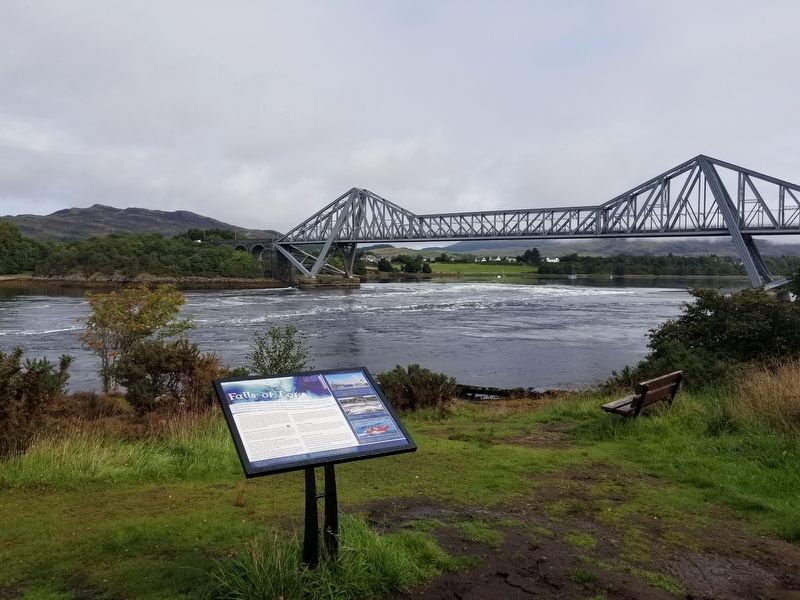Oban in Argyll and Bute, Scotland, United Kingdom — Northwestern Europe (the British Isles)
Falls of Lora
About Tides
Tides are caused by the gravitational pull of the sun and moon and the rotation of Earth. When the sun and moon are pulling in the same direction during full and new moon, the tides are strong and called spring tides. Neap tides with a narrower tidal range occur during half moon when the sun and moon pull water in different directions. Our shorelines experience two high and low tides each day, with each tidal cycle taking about 12 hours and 20 minutes.
When are the best times to see the Falls?
The Falls are most spectacular on the ebbing spring tides when water pours out of Loch Etive. You can access tables telling you the best times online (scan QR code or visit www.fallsoflora.info) or by consulting paper copies in the Oyster Inn behind you.
How are the Falls of Lora generated?
Both the Firth of Lorn and Loch Etive are deep coastal areas containing large volumes of water that respond to the tides. This water tries to flow in and out of Loch Etive via a very shallow rocky exit here at the Falls.
As the constriction is so great, not all the water is able to pass through the Falls so that a typically 3m tidal range at Oban corresponds to only a 1.3m tidal range at Bonawe half way up Loch Etive. Visit www.fallsoflora.info for more details.
How fast does the water flow through the Falls?
About 66 million cubic metres of water try to squeeze through the Falls during each ebbing and flooding tide. The current on a big ebb tide runs at about 4,600 tonnes per second — at up to 12 knots.
Ferry and bridge
People have been crossing here since the 16th century. Before the 160m long cantilever bridge was built in 1903 (originally for a single-track railway), a rowing boat with four oarsmen ferried people, horses and carriages across the Falls.
What lives in the Falls?
This is an extremely turbulent stretch of water where lots of nutrients and plankton rush past with the currents, making it a great place for marine life that is solidly stuck to the seabed. Also many different seabirds and occasionally seals and otters can be seen feeding in the Falls.
Visit the Ocean Explorer Centre next to Dunstaffnage Castle to find out more about the local marine environment. ( photo captions )
A 30 m deep channel near the southern bridge pier allows experienced
local pilots steer large ships through the Falls at slack water. The Great Glen Shipping Co ship MV Isis, piloted by John Campbell of Ardchattan, often carries logs from Glen Etive Forest and aggregates from Bonawe Quarry out of Loch Etive. The Scottish Association for Marine Science's research vessels also cross through the Falls regularly en route to science stations and to teach students about oceanography in Loch Etive.
When the tidal conditions are right, the Falls are an experienced kayaker's dream. Advanced divers use the Falls for drift diving and have to manoeuvre fierce vertical eddies. (Photo: Simon Willis)
The tidal race at the Falls of Lora is very popular for rescue exercises conducted by the Scottish Fire & Rescue Service and the RNLI Lifeboats. (Copyright The TurfBurner, licensed for reuse under the Creative Commons Licence.)
This board was erected by the West Connel Mooring Owners’ Association to honour two eminent marine scientists from the Scotish Association for Marine Science (SAMS): Professor Laurence David Mee and Harry Powell, who was also Secretary of Connel Community Council.
With assistance from Connel Community Council, SAMS, Great Glen Shipping, The Falls of Lora Hgotel, John Campbell, Oban & Lorn Tourism Association, The Oyster Inn, Seafreedom Kayak, West Highland Anchorages & Moorings, West Highland Housing Association.
Topics. This historical marker is listed in this topic list: Waterways & Vessels. A significant historical year for this entry is 1903.
Location. 56° 27.304′ N, 5° 23.631′ W. Marker is in Oban, Scotland, in Argyll and Bute. Marker is at the intersection of Route A85 and Lora Falls Bridge (Route A828), on the right when traveling south on Route A85. Touch for map. Marker is in this post office area: Oban, Scotland PA37, United Kingdom. Touch for directions.
Other nearby markers. At least 8 other markers are within 6 kilometers of this marker, measured as the crow flies. Dunstaffnage Castle (approx. 2.7 kilometers away); A Towering Outlook (approx. 2.7 kilometers away); Behind the Walls (approx. 2.7 kilometers away); Justice and Joviality (approx. 2.7 kilometers away); A Hidden Haven (approx. 2.7 kilometers away); Core of the Castle (approx. 2.7 kilometers away); Watching, Waiting and Warning (approx. 2.7 kilometers away); McCaig’s Tower (approx. 6.4 kilometers away). Touch for a list and map of all markers in Oban.
Also see . . . The Falls of Lora. (Submitted on December 17, 2018, by Michael Herrick of Southbury, Connecticut.)
Credits. This page was last revised on January 27, 2022. It was originally submitted on December 17, 2018, by Michael Herrick of Southbury, Connecticut. This page has been viewed 232 times since then and 33 times this year. Photos: 1, 2. submitted on December 17, 2018, by Michael Herrick of Southbury, Connecticut.

